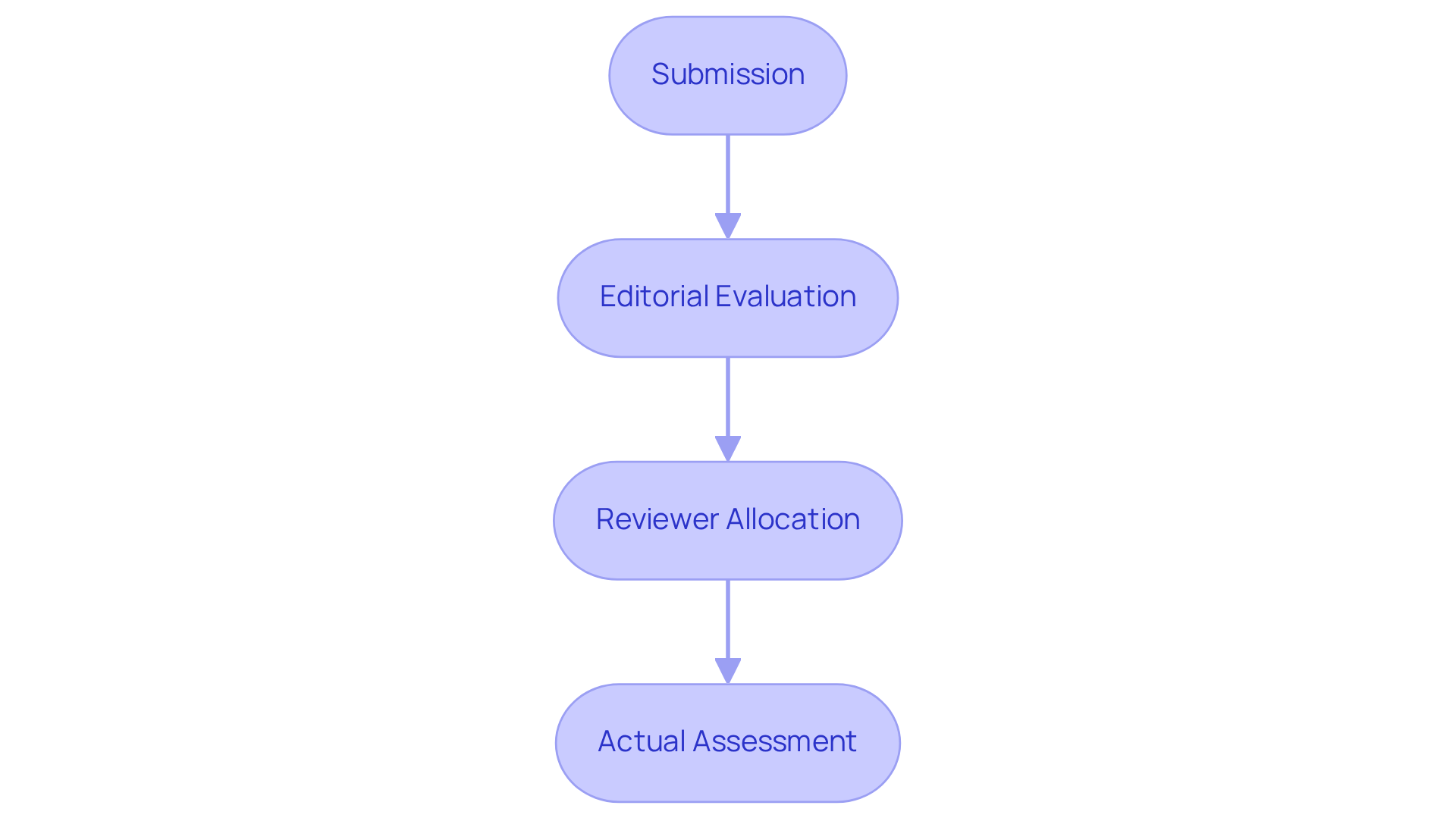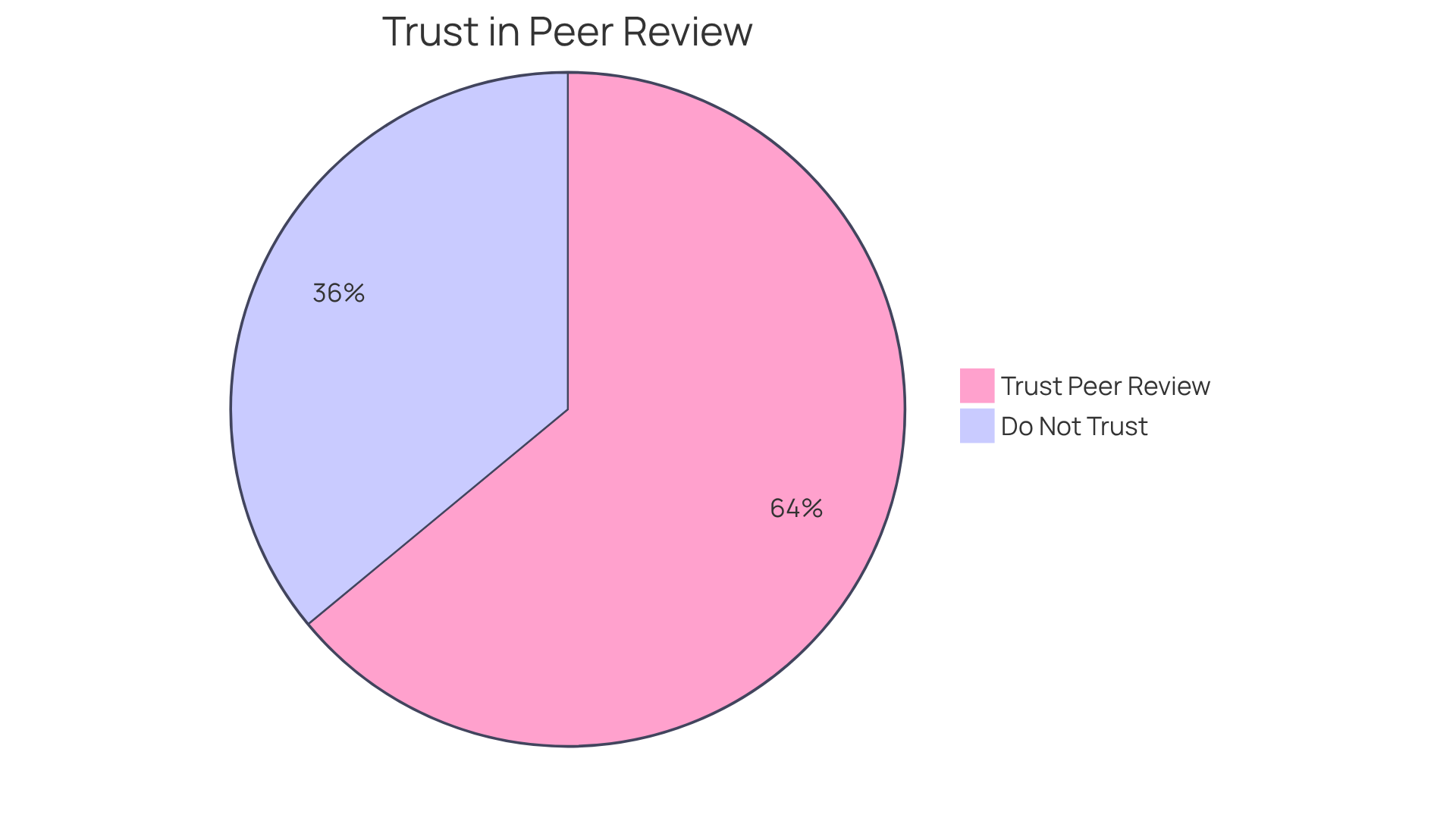September 10, 2025

The term "Under Review" in peer review processes signifies that a manuscript is currently undergoing evaluation by field experts to assess its quality and relevance prior to publication. This phase is critical, as it involves rigorous scrutiny by assigned reviewers who provide essential feedback. Such feedback ensures that only studies meeting high standards are accepted, thereby upholding the integrity of academic literature.
Understanding the peer review process is essential for anyone navigating the complex landscape of academic publishing. This rigorous evaluation system not only determines the quality and validity of scholarly work but also plays a crucial role in maintaining the integrity of research across various fields.
However, many authors and researchers find themselves pondering the implications of the status 'under review.' What does it truly signify in the context of peer evaluation? How does it impact the journey of a manuscript from submission to publication?
Delving into these questions is vital for comprehending the nuances of academic publishing.
Peer assessment stands as a systematic evaluation where specialists within a specific domain critically scrutinize the quality, validity, and relevance of a manuscript prior to its publication in a scholarly journal. This essential process encompasses several phases:
The primary objective of this evaluation is to uphold stringent , ensuring that published studies not only meet established criteria but also contribute significantly to the field. As Adrian Stanley, an independent consultant, articulates, "Peer assessment is the foundation of scholarly communication, merging human expertise with critical evaluation to maintain the quality of academic work."
Functioning as a vital quality control mechanism, peer assessment effectively filters out inferior studies, thus enhancing the credibility of published work. Notably, research indicates that approximately 32% of submitted manuscripts receive approval after undergoing this rigorous evaluation process, underscoring the significance of peer assessment in academic publishing.
Furthermore, this evaluation has been shown to elevate study quality, as constructive feedback from evaluators often motivates authors to refine their arguments and methodologies, ultimately resulting in more robust and impactful publications. For healthcare employers, understanding this evaluation system is crucial, as it directly influences the quality of studies that inform hiring decisions and the competency of candidates in the field of Applied Behavior Analysis.

Peer evaluation serves as a cornerstone in both academic and professional arenas, fundamentally ensuring the integrity of studies and the trustworthiness of results. In fields such as medicine, psychology, and education, peer-reviewed articles are unequivocally viewed as the gold standard for evidence-based practice. Notably, approximately 64% of healthcare professionals depend on peer-reviewed literature to inform their clinical decisions. This reliance underscores the critical role plays in shaping effective treatment protocols.
The evaluation process not only enhances the quality of studies but also cultivates trust among scholars, practitioners, and the public. By subjecting research to rigorous scrutiny, collective assessment significantly mitigates the risk of disseminating flawed or misleading information. This safeguard is vital for the advancement of knowledge across various disciplines.
As specialists emphasize, the evaluation process is imperative for upholding high standards in academic publishing. It strengthens the function of fostering trustworthy and influential research. Are you confident in the reliability of the studies that inform your practice? By prioritizing peer evaluation, we can collectively elevate the standards of research and ensure that our decisions are based on sound evidence.

The origins of collegial evaluation can be traced back to the 17th century, coinciding with the establishment of the first scientific journals. The Royal Society of London, founded in 1665, is often credited with initiating the assessment method as we recognize it today. Initially, collaborative evaluation was informal, primarily involving the editor soliciting input from trusted colleagues.
As the number of research publications surged, particularly in the 20th century, the assessment process evolved into a more structured system. Today, it stands as a , employing various models such as single-blind, double-blind, and open evaluations to enhance transparency and objectivity.
However, challenges remain, including insufficient training in delivering constructive feedback, which can result in superficial evaluations. As noted by Northcraft and Tenbrunsel, engaging in mutual evaluation allows evaluators to gain new insights and concepts, benefiting both authors and the scientific community.
Furthermore, historical case studies, including the development of evaluation practices in China, illustrate the complexities and adaptations of this system throughout history. This evolution signifies a growing commitment to upholding the integrity and quality of scientific discourse.

The peer evaluation system serves as a pivotal mechanism in academic publishing, encompassing several essential elements:
Initially, upon submission, a manuscript undergoes an editorial check to ensure compliance with the journal's standards. If it meets these criteria, the editor assigns it to a select group of reviewers—typically averaging three per manuscript—who are experts in the relevant field. These reviewers meticulously assess the manuscript's originality, methodology, and significance, providing constructive feedback and recommendations for improvement.
Following the assessment, the editor synthesizes the feedback to make a publication decision, which may involve acceptance, requests for revisions, or outright rejection, ultimately helping to explain what does under review mean. This rigorous procedure, with an average acceptance rate of approximately 29%, though fluctuating between 12% and 63% among various journals, guarantees that only high-quality studies are disseminated, thereby upholding the integrity of academic literature.
Notably, around one in three articles submitted to reviewers is accepted, illustrating the competitive nature of the evaluation process. The average time from submission to the first decision is about 24 days, underscoring the efficiency of this structured approach. Ultimately, the organized nature of peer review not only enhances the but also fosters a culture of continuous improvement and accountability within the research community.

The peer review process stands as a cornerstone of academic publishing, functioning as a rigorous mechanism that upholds the quality and integrity of scholarly work. By subjecting manuscripts to critical evaluation by field experts, this process not only filters out subpar studies but also significantly enhances the reliability of published research. Recognizing the implications of the "Under Review" status is essential, as it indicates that a manuscript is undergoing this vital scrutiny, a step that ultimately determines its acceptance and contribution to the academic community.
Key points throughout the article underscore the structured phases of peer review, its historical evolution, and its crucial role in maintaining scholarly standards. This process fosters trust among researchers and practitioners, especially in fields where accurate and reliable information is paramount, such as healthcare and education. The statistics presented reveal the competitive nature of peer review, with only a fraction of submissions progressing to publication, underscoring the necessity for high-quality research.
In conclusion, the peer review system transcends mere procedural formality; it is fundamental to academic integrity and research quality. As the landscape of scholarly communication evolves, embracing and understanding the nuances of peer review empowers researchers, practitioners, and readers alike. By prioritizing rigorous evaluation, the academic community ensures that the studies informing practice are credible and impactful, ultimately advancing knowledge across various disciplines.
What is peer review?
Peer review is a systematic evaluation process where specialists in a specific field critically assess the quality, validity, and relevance of a manuscript before it is published in a scholarly journal.
What are the main phases of the peer review process?
The main phases of the peer review process include submission, editorial evaluation, reviewer allocation, and the actual assessment conducted by colleagues.
What is the primary objective of peer review?
The primary objective of peer review is to uphold stringent quality standards, ensuring that published studies meet established criteria and contribute significantly to the field.
How does peer review enhance the credibility of published work?
Peer review functions as a vital quality control mechanism that filters out inferior studies, thereby enhancing the credibility of published work.
What percentage of submitted manuscripts typically receive approval after peer review?
Approximately 32% of submitted manuscripts receive approval after undergoing the peer review process.
How does peer review improve the quality of studies?
Peer review improves the quality of studies by providing constructive feedback from evaluators, which motivates authors to refine their arguments and methodologies, resulting in more robust and impactful publications.
Why is understanding the peer review process important for healthcare employers?
Understanding the peer review process is crucial for healthcare employers because it directly influences the quality of studies that inform hiring decisions and the competency of candidates in the field of Applied Behavior Analysis.
Our expert recruitment strategies and AI-driven sourcing ensure that you receive top-notch candidates quickly, without compromising on quality. Whether you’re looking for BCBAs, Clinical Directors, or RBTs, we’ve got you covered.